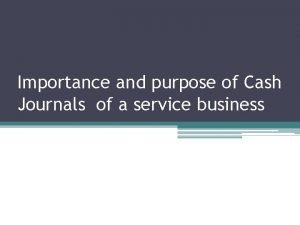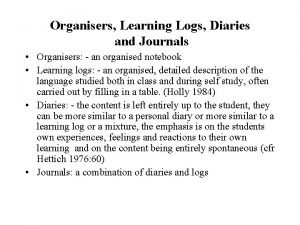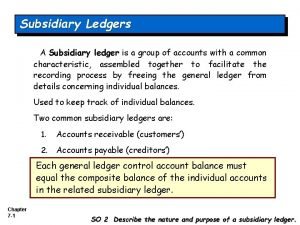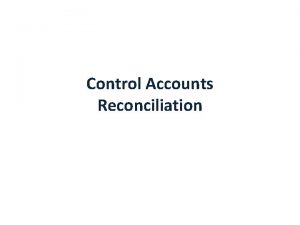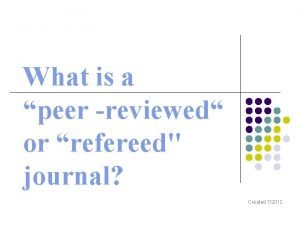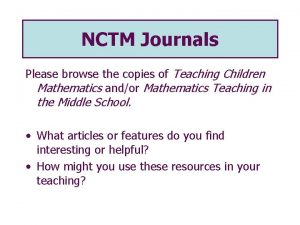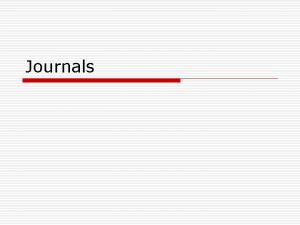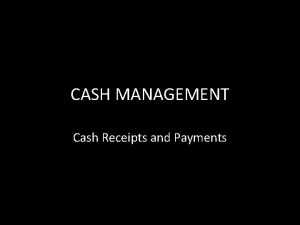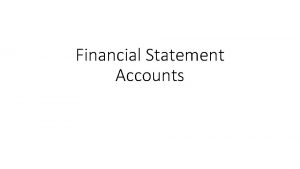Importance and purpose of Cash Journals of a








- Slides: 8

Importance and purpose of Cash Journals of a service business

Cash Journals • Used to record day to day transactions of a business • Source documents are recorded in journals which include cash journals • Cash journal= record all cash transactions of a business (the receipts and payments) • At the end of the month the totals are posted to the General Ledger • Cash journals are updated daily and it show the detail of each transaction • -date • -invoice/receipt/cheque number • -Who it was paid to/received from • -Amount paid/received • -What it was for

• Cash Journals are a quick reference to trace a transaction • It show all the cash you received on a daily basis and what you spent that cash on • It help to control the receipts and payments of your business daily • Two main Journals 1 - Cash Receipts Journal and 2 -Cash Payments Journals

Activity 2: CLASS DISCUSSION Identify journals Indicate in which journals the following transactions will be recorded in the books of Lehobye Electricians. Nr Transaction 1 F. Lehobye deposited money as capital contribution into the business bank account Buy a building to do business from for cash Buy equipment cash to render a service Receive money from clients for rendering a service 2 3 4 5 6 Pay weekly wages to his employees The owner rented part of the building to his sister to start a catering business. Receive her first month rental 7 Deposit cash and cheques into the business current account The bank levied bank charges A stop order for insurance The money takes money for personal use 8 9 10 Journal

POSSIBLE ANSWERS: Nr 1 2 3 4 5 6 7 8 9 10 Transaction F. Lehobye deposited money as capital contribution into the business bank account Buy a building to do business from for cash Buy equipment cash to render a service Receive money from clients for rendering a service Pay weekly wages to his employees The owner rented part of the building to his sister to start a catering business. Receive her first month rental Deposit cash and cheques into the business current account The bank levied bank charges A stop order for insurance The money takes money for personal use Journal CRJ CPJ CRJ No journal CPJ CPJ

Activity 3: HOMEWORK General Ledger and Trial balance Answer the following questions in your work book. 1. Explain the double-entry system. 2. State the meaning of the term “General Ledger’. 3. Explain why a General Ledger account looks like a T-account. 4. Identify the purpose of the Trial Balance. 5. State when a Trial Balance will be drawn up. 6. Describe what it means if a Trial Balance ‘balances’

POSSIBLE ANSWERS: 1. The double-entry principle means that for every debit entry there must be a matching credit entry in the ledger. (For every debit (Dr) entry there must be a corresponding credit (Cr) entry in the ledger). 2. The General Ledger is a list of all accounts that the business has. Each account has details of any transactions relating to that specific account. 3. The General Ledger has a left-side and a matching right-hand side. The heading is written at the top of both sides. This looks like a T. 4. The purpose of the Trial Balance is to make sure that every debit has a matching credit entry. The debit and credit sides must add up to the same amount. It test the double entry system used in the ledger. 5. End of the month. 6. It means that the debit and credit sides add up to the same amount. The double entry system was correctly used in the ledger.

ACTIVITY 8. 1 AND 8. 2 P 82, 83 HOMEWORK
